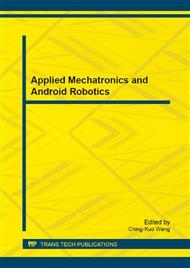[1]
Li Xiaopeng, Liu Chunshi, Ma Xiaobo, Li Hui. Improvement Technology and Research Contents of Machining Accuracy for CNC Machine Tools. Modular Machine Tool & Automatic Manufacturing Technique. Vol. 11, pp.1-4, (2010).
Google Scholar
[2]
Kang Fang, Fan Jinwei. A Method for Manufacturing Accuracy Distribution and Optimization of a CNC Machine Tool. Mechanical Science and Technology for Aerospace Engineering. Vol. 27, No. 5, pp.588-591, (2008).
Google Scholar
[3]
Huang Xiaodiao, Ding Wenzheng, Hong Rongjing. Study on Accuracy Design of Multi-axis Machine Tools Oriented to Remanufacturing. Journal of Basic Science and Engineering. Vol. 15, No. 4, pp.559-568, (2006).
DOI: 10.1049/cp:20060987
Google Scholar
[4]
Lu Qiang, Zhang Youliang. Accuracy Synthesis of a Hexapod Machine Tool Based on Monte-Carlo Method. China Mechanical Engineering. Vol. 13, No. 6, pp.464-467, (2002).
Google Scholar
[5]
Zhao Xueman, Ni Yanbing, Xu Shujing. Accuracy Design of Key Components for Parallel Machine Tool. Machine Tool and Hydraulics. No. 5, pp.58-59. (2004).
Google Scholar
[6]
U. Dorndorf, V. S. B. Kiridena, P. M. Ferreira. Optimal Budgeting of Quasistatic Machine Tool Errors. Transactions of the ASME. Journal of Engineering for Industry. Vol. 116, No. 42, pp.42-53, (1994).
DOI: 10.1115/1.2901808
Google Scholar
[7]
Su Shipin, Li Shengyi, Wang Guilin. A Universal Synthetic Volumetric Error Model of Multi-axis NC Machine Tool Based on Kinematics. Journal of National University of Defense Technology. Vol. 23, No. 4, (2001).
Google Scholar
[8]
G. Taguchi, Y. Wu. Introduction to Off-Line Quality Control. Central Japan Quality Control Association. (1985).
Google Scholar
[9]
Hoo-Gon R. Choi, Man-Hee Park. Optimal Tolerance Allocation With Loss Functions. Journal of Manufacturing Science and Engineering. Vol. 122, pp.529-535, (2000).
DOI: 10.1115/1.1285918
Google Scholar
[10]
Yang Jiangxin, Wu Zaotong, Gu Daqiang. Research on cost-tolerance model based on manufacturing feature. Engineering Design. Vol. 3, pp.22-24, (1995).
Google Scholar
[11]
Test conditions for machining centres—Part 2: Geomtric tests for machines with vertical spindle or universal heads with vertical primary rotary axis (vertical Z-axis) GB/T 20957. 2-2007 ISO10791-2: 2001, MOD.
DOI: 10.3403/02222895
Google Scholar
[12]
DEB K, PRATAP A, AGRAWAL S, et al. A Fast and Elitist Multi-objective Genetic Algorithm: NSGA-II [J]. IEEE Transactions on Evolutionary Computation. Vol. 6, No. 2, pp.182-197, (2002).
DOI: 10.1109/4235.996017
Google Scholar
[13]
Test conditions for precision machining centres—Part 7: Accuracy of a finished test piece GB/T 20957. 7-2007 ISO10791-7: 1998, MOD.
DOI: 10.3403/01371743
Google Scholar


